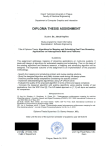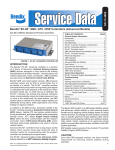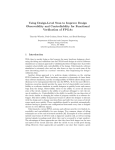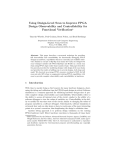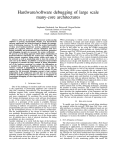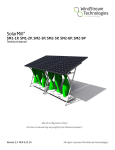Download Real-Time Multiprocessor Architecture for Sharing Stream
Transcript
2015 IEEE International Parallel and Distributed Processing Symposium Workshops Real-Time Multiprocessor Architecture for Sharing Stream Processing Accelerators Berend H.J. Dekens∗ Marco J.G. Bekooij∗‡ ∗ ‡ Department of EEMCS University of Twente Enschede, The Netherlands NXP Semiconductors Eindhoven, The Netherlands However, sharing of accelerators is challenging under realtime constraints as a system implementation is required which can be captured in a temporal analysis model. With such an analysis model the minimum granularity at which blocks of data, i.e. the block size, must be multiplexed over the accelerators can be computed given the minimum throughput requirement of a stream of data of an application. Computation of the minimum granularity is complicated by the fact that a larger granularity amortizes accelerator reconfiguration overhead and thereby increases the throughput of one stream. However, this results also in a longer occupation of the accelerators and thereby reduces the throughput of other streams that share the same accelerator. As such, there is a mutual dependency between the minimum block sizes for different streams. Another complicating factor is that intuitively a smaller block size should result in a smaller buffer capacity but this is not generally the case because the required buffer capacities are a non-monotonic function in the block sizes. As a result the total required memory size for buffering is a non-monotonic function in the block size as well. In this paper we present an approach for sharing accelerators under real-time constraints in a multiprocessor architecture for stream processing applications. Sharing of stream processing accelerators is enabled by multiplexing data streams using so-called entry- and exit-gateways. These gateway pairs check for sufficient input data and output space at respectively the input and output of a chain of accelerators such that the minimum throughput can be derived using a Cyclo-Static Data Flow (CSDF) model [1]. An abstraction of this CSDF model is created in the form of a single actor Synchronous Data Flow (SDF) model. This SDF model enables the derivation of an Integer Linear Program (ILP) for the computation of the minimum granularity at which blocks of data from the streams must be multiplexed over shared accelerators. The achieved reduction in hardware cost has been evaluated by creating a multiprocessor system with shared accelerators that is implemented on a Virtex 6 FPGA. This system has been evaluated using a real-time Phase Alternating Line (PAL) stereo audio decoder application. The outline of this paper is as follows. In the next Abstract—Stream processing accelerators are often applied in MPSoCs for software defined radios. Sharing of these accelerators between different streams could improve their utilization and reduce thereby the hardware cost but is challenging under real-time constraints. In this paper we introduce entry- and exit-gateways that are responsible for multiplexing blocks of data over accelerators under real-time constraints. These gateways check for the availability of sufficient data and space and thereby enable the derivation of a dataflow model of the application. The dataflow model is used to verify the worst-case temporal behavior based on the sizes of the blocks of data used for multiplexing. We demonstrate that required buffer capacities are non-monotone in the block size. Therefore, an ILP is presented to compute minimum block sizes and sufficient buffer capacities. The benefits of sharing accelerators are demonstrated using a multi-core system that is implemented on a Virtex 6 FPGA. A stereo audio stream from a PAL video signal is demodulated in this system in real-time where two accelerators are shared within and between two streams. In this system sharing reduces the number of accelerators by 75% and reduced the number of logic cells with 63%. Keywords-real-time applications; stream processing accelerators; dataflow; accelerator sharing; multiprocessing systems I. I NTRODUCTION Nowadays programmable signal processors are applied in Software Defined Radios (SDRs). A hardware cost reduction can be achieved by specialization of the instruction set of these Digital Signal Processors (DSPs). However, the design effort and associated cost to create such processors and their accompanying compilation tool-chains can be significant. Stream processing hardware accelerators can be an attractive alternative compared to the use of specialized DSPs. These accelerators can improve the performance and powerefficiency at the cost of reduced flexibility. Sharing of accelerators between data streams could improve their utilization and reduce thereby hardware costs. Accelerators can be shared by different streams within one application or by data streams from different radios that are executed simultaneously on the multiprocessor system. This work is supported by the SenSafety project in the Dutch COMMIT program (commit-nl.nl). /15 $31.00 © 2015 IEEE DOI 10.1109/IPDPSW.2015.147 Gerard J.M. Smit∗ 81 section we will describe related work. The basic idea behind our approach is described in Section III. In Section IV we describe our architecture with gateways in detail. The derivation of the temporal analysis models in the form of a CSDF and the more abstract SDF model are described in Section V. The evaluation of our system in terms of hardware costs and utilization of the accelerators using a real-time PAL stereo audio decoder application is described in Section VI. The conclusion is stated in the last section. P T2 P T3 G2 Acc2 G3 P T4 G1 P T1 dual-ring interconnect P T0 Figure 1. II. R ELATED W ORK G0 Acc0 Acc1 Example architecture overview with all types of tiles to provide real-time guarantees. Accelerators stream data through FIFO channels, hiding all network aspects. Like our design, a special bus is used to configure accelerators while a streaming network handles all data. Processors in [9] are not connected to the data streaming interconnect, unlike our approach, making it impossible to integrate them in a stream processing application directly. Multiplexing of data streams is supported where state is retained within the accelerators, limiting the number of multiplexed streams per accelerator. Eclipse [10] employs a shell to integrate stream processing accelerators, an approach similar to the network [11] used in our design. The use of the C-FIFO [12] algorithm in a hardware shell results in larger hardware costs than our credit-based hardware flow-control support in our network. A shell around every accelerator manages arbitration between multiplexing data streams. Our implementation only requires logic for arbitration in the gateways instead of in every accelerator. There is no temporal analysis model presented and performance is measured instead within a simulator. Our approach of using a network to stream data between accelerators and a dedicated bus to save and restore accelerator state is similar to [13]. However, the use of a switch to implement point-to-point connections results in higher hardware costs compared to the ring-based interconnect of [14], [11] which is used in this paper. The interconnect from [13] provides real-time guarantees but lacks support to share accelerators. Hardware accelerators can be integrated into systems as Instruction-Set Extensions (ISEs), by means of Remote Procedure Calls (RPCs) or by making use of Direct Memory Access (DMAs). We additionally will describe architectures designed for accelerator integration which employ DMAs. ISEs allow fine grained interaction with application specific accelerator hardware due to a low communication latency and usually without synchronization overhead. This type of accelerator integration is applied in (general purpose) processors [2], [3], [4] and proposed as a way to save power by integrating so-called conservation cores [5]. A potential drawback is that the processor is usually stalled until the accelerator returns the result which limits the maximum achievable performance gain. An additional drawback is that accelerators usually belong to a single core, preventing sharing between cores to improve utilization. The use of RPCs [6] allows a less tight integration between processors and accelerators. For communication with accelerators synchronization needs to be added which results in some overhead. While concurrent processing of processor and accelerator is possible in theory, in practice it is difficult as results from the accelerator are often required for application progression. Additionally, it is not trivial to keep the processor occupied during the exact duration of the RPC call to maximize performance gains [7]. An architecture which makes use of DMAs for the communication with accelerators is described in [8] and allows concurrent processing of data streams by processors and accelerators. In [8] they also describe a CSDF model for the derivation of the minimum throughput for the case that accelerators are shared by multiple streams. What is missing in [8] is the check for space at the output of a chain of accelerators, before processing of a block of data begins. Without this check, no correct CSDF model can be derived. Furthermore, determining an appropriate block size for every multiplexed stream given a throughput constraint has not been addressed in [8]. We will introduce a single actor SDF model for the derivation of the minimum block size which takes both the overhead caused by the flushing the data out of a pipeline of accelerators and the time needed for saving the state of the accelerators into account. PROPHID [9] is an architecture which uses a crossbar with a pre-calculated Time Division Multiplex (TDM) schema III. BASIC I DEA In this section we present a high level overview of our architecture and the relation with the dataflow models used for the derivation of the minimum block size. An overview of our hardware architecture is shown in Figure 1. In this architecture an entry-gateway hardware block is responsible for scheduling blocks of data from different streams over a chain of accelerators. Streaming of a block of data is only allowed if: 1) the exit-gateway has indicated that all data in the chain of accelerators belonging to the previous block has been processed so a context switch can be performed, and: 2) enough space is available at the output buffer such that a consuming task can receive the next block of data without having to stall for additional space in this buffer 82 A CSDF model suitable for temporal analysis can be created for this hardware, which is shown simplified for clarity in Figure 2. We show that one CSDF model per stream can be created despite that accelerators are shared. This CSDF model is a conservative abstraction of the hardware implementation. We will show that the minimum throughput can be derived using this model. We will use the symbol to indicate that the CSDF model is a conservative abstraction of the hardware. As such, the hardware is a temporal refinement of this model, according to the-earlier-the-better [15], [16] refinement theory. This theory is applicable if the application is functional deterministic and for each component it holds that: they are enabled. Actors are enabled if sufficient tokens are available in their input queues. During the construction of this schedule we use worst-case firing durations of the actors. These firing durations are equal to the maximum durations between arrival of the data enabling a task such that it becomes eligible for execution and the actual production of data by this task. Tasks can be executed by accelerators or by processors. The block size determines the number of samples to be processed by the accelerators before a block of another stream can be processed. To derive the block size using the dataflow model we cannot make use of Maximum Cycle Mean (MCM) analysis techniques [17] as these analysis techniques require that expansion into an Homogeneous Synchronous Data Flow (HSDF) graph is possible [1]. However, an HSDF graph with a fixed topology cannot be derived as the block size remains a variable parameter in the CSDF model. Instead of computing the MCM we construct a schedule that is parameterized in the block size. We will show that a more compact parameterized SDF model can be created from this CSDF model with a minimum loss of accuracy. As such, the CSDF model is a refinement of the SDF model, as is indicated in Figure 2. Due to transitivity of the relation we can conclude that also the hardware is a refinement of this SDF model. We will show that this SDF model is suitable for the derivation of the minimum block size such that the throughput constraint of the application is satisfied despite overhead of saving the state and flushing data out of the FIFO buffers between the accelerators. ∀i, a(i) ≤ â(i) ⇒ ∀j, b(j) ≤ b̂(j) This equation states that an earlier arrival of the i-th input token at time a(i) in the refined model compared to the arrival of the corresponding token in the abstraction at â(i) should not result in a later production of the token by the refined model at b(j) compared to production of the corresponding j-th token by the abstraction at b̂(j). This equation can be generalized for components with multiple inputs and outputs. If the equation holds we say that component C refines component C and this is formalized as C C . A component can be an actor, its corresponding task or subgraphs of actors or tasks. If the refinement relation holds per component than it holds also for a complete graph of components. This means that the worst-case throughput and latency of the refined graphs is always better than the model being refined, i.e. the model obtained by abstraction. As such temporal guarantees concerning maximum token arrival times derived for the abstract model are always valid for the refined model and this also holds for subgraphs of these models. As a result, it is sufficient to show that a schedule of the abstract model exists that satisfies the temporal requirements. We can therefore determine the minimum throughput by creating an admissible schedule for the CSDF graph at design time. In an admissible schedule actors do not fire before ρ P0 ρ v P0 ρ v P0 v G0 G0 vA0,1 SDF ρ P0 A0,1 ρ A0 v A0 CSDF ρ C0 IV. P ROPOSED A RCHITECTURE In this section we will introduce the heterogeneous Multiple Processor System on Chip (MPSoC) architecture for real-time stream processing applications [11] which was extended with support for sharing stream processing accelerators. It consists of a number of interconnected “tiles” which contain processing elements. In Figure 1 an overview of our architecture is presented. The “tiles” come in four types: the “Processor Tile” (PT), which contains a processor and some peripherals, the “Accelerator Tile” (Acc) which contains a configurable stream accelerator, the “entry-gateway” tile (G0/G2) and the “exitgateway” tile (G1/G3). Each pair of entry- and exit-gateways handles multiplexing of data streams over a specific set of accelerator tiles. As reconfigurating or replacing state within the accelerators while data is still being processed in those accelerators would result in corrupt data, the entry- and exitgateway work together to ensure that the pipeline is idle before another data stream is multiplexed. Such a pair of gateways is indicated by the dashed boxes in Figure 1. As interconnect we use the low-cost dual communication ring network from [11]. We will present the different types of tiles in more detail in the following sections. v C0 ρ A1 ρ v A1 v G1 G1 ρ C0 v C0 P0 Entry Gateway P1 A0 A1 C0 Exit Gateway C1 Reality Figure 2. Basic idea for sharing accelerators 83 dual-ring interconnect dual-ring interconnect dual-ring interconnect dual-ring interconnect Timer IRQ Ring FIFO IRQ Timer C-FIFO Ring FIFO D A+D DMA C-FIFO Memory Memory μBlaze PLB Bus LMB LMB PLB Bus Accelerator DMA μBlaze BRAM BRAM Processor Tile Accelerator Tile acc. configuration bus (a) Processor Tile Figure 3. Exit Entry-gateway acc. cfg. bus (b) Accelerator Tile (a) Entry-gateway Overview of Processor and Accelerator tiles Figure 4. A. Processor Tile -gateway cfg (b) Exit-gateway Overview of both gateway types receive one data stream from an accelerator tile and send one data stream to an accelerator tile to minimize hardware costs. Figure 3a shows an overview of a processor tile. Every tile contains a RISC Microblaze processor and some peripherals like a timer for interrupts, a small local memory for a bootloader and a small data scratch pad memory. Every processor is equipped with an instruction and data cache which is sufficiently large to cache program code of tasks running on the processor. Tasks are governed by a real-time budget scheduler [18] from a POSIX compliant kernel with multithreading support which was developed for this system. Every processing tile is connected to a tree-shaped interconnect providing fair access to external memory, which is for the case study presented in this paper unused and as such is omitted in the rest of this paper. It also has a connection to a dual-ring interconnect providing streaming tile-to-tile communication for data streams. In order to keep hardware costs low, the inter-tile interconnect only supports posted writes: a write completes for a producer when the interconnect accepts, it does not wait until the write actually arrives at its destination memory. The interconnect provides lossless communication where guaranteed acceptance at every tile is required to prevent loss of data which removes the need for hardware flow control for communication with memories. Tiles can only write data to a remote memory; when data from a remote tile is needed, both tiles need to work together to exchange data. Processor tiles support two types of data streams: software FIFO communication, using the C-FIFO [12] algorithm, which allows an arbitrary number of simultaneous streams between processing tiles or hardware FIFO communication which is used to communicate directly with accelerator tiles. To support hardware FIFO communication we use a credit based flow control mechanism. This is implemented with a second ring for the communication of credits in the opposite direction as the data [11]. Currently it is only possible to B. Accelerator Tile Accelerator tiles, as depicted in Figure 3b, consist of a coarsely programmable accelerator and a streaming I/O port to the inter-tile dual-ring interconnect. The network interface handles the transition from address based communication to streaming data [11]. As such, the accelerators have no notion of other aspects of the system: they consume an incoming data stream from the Network Interface (NI) and produce a data stream which is returned to the NI. Accelerators can stall the incoming or outgoing stream of data tokens if they run out of data or space. To this end, the NIs for accelerators use a credit-based flow control algorithm. Each accelerator is connected to a bus to load and save its state and configuration. This is used to provide context switches when different data streams are multiplexed. Accelerators are chained together at run-time by a description written by a programmer which describes the flow of data between tiles. A support library abstracts the implementation details and allows a programmer to simply connect blocks of functionality in a programming language like C. C. Gateways Entry-gateways are based on processor tiles and as such contain the same components plus some components needed for managing accelerators and multiplexing data streams, as is shown in Figure 4a. Configuration and state of accelerators are loaded and saved by means of a configuration bus which is connected to all managed accelerators. Configuration and state are stored in the local memory of the entry-gateway for every multiplexed stream. To prevent the speed of the 84 B. CSDF Model processor becoming a bottleneck in the data path, data is forwarded to the accelerators by a small DMA. The entry-gateways handle streams using a Round-Robin (RR) scheduling policy. The use of RR allows to multiplex unrelated streams for multiple applications that are being executed simultaneously on the MPSoC. Data streams arriving at the entry-gateway use software FIFOs store their data in the dual ported C-FIFO memory. The DMA controller copies data for the currently active stream from this local FIFO memory to an accelerator using hardware credit-based flow control. Produced data by the last accelerator in the chain is passed to the exit-gateway, which converts from hardware to software flow control, to a processing tile or entry-gateway. The exit-gateway is an accelerator containing a DMA converting the hardware flow-controlled data stream to the address based software flow-controlled FIFO, as is shown in Figure 4b. When the last sample from a data block passed through the exit-gateway, the entry-gateway is notified that the pipeline is idle and another data stream can be multiplexed. In our approach gateways are used for multiplexing of data streams over a set of accelerators. For each stream that is multiplexed over the accelerators a separate CSDF model is created. A CSDF model for one such stream is shown in Figure 5. To keep the figure concise we assume, without loss of generality, that only one accelerator is shared. This accelerator is modeled with actor vA . The values of α1 and α2 are two tokens and are equal to the capacity of the buffers in the network interfaces. In the CSDF model, the entry-gateway is modeled by actor vG0 and the exit-gateway is modeled by vG1 . The first phase of vG0 can not start before vG1 has produced a token on the edge (vG1 , vG0 ) which indicates that the previous block of data has been processed. Additionally vC must have produced ηs tokens to indicate that ηs locations are available in the input buffer of vC . Furthermore at least ηs tokens have been produced by actor vP before the first phase of vG0 can start. Actor vG0 produces ηs tokens, one in each phase. All phases denote the transfer of a sample to the shared accelerator vA . Actor vA will consume each token and produce a token for the exit gateway actor vG1 . After vG1 has produced ηs tokens for actor vC , with each token modeling an output sample from the shared accelerator to the consumer, it produces a token to notify vG0 that the pipeline is idle. The time that other streams might use the accelerators before stream s ∈ S can be processed, denoted by s is a function in the block sizes of all other streams and is included in the firing duration of the first phase of actor vG0 . The set S contains all streams multiplexed by an entry/exit-gateway pair over a set of accelerators. The time Rs required to reconfigure the accelerators for stream s is also included as well as the time it takes for vG0 to copy a sample, which is denoted by . As such, the firing duration of ρG0 [0] becomes: (1) ρG0 [0] = s + Rs + V. DATAFLOW M ODEL In this section the CSDF model of our sharing approach for accelerators and its SDF abstraction are explained in detail. We will now first provide a brief introduction into these models and then present a detailed CSDF model for a single data stream using a shared accelerator followed by its abstraction into a SDF model. A. (C)SDF An SDF model is a directed graph G = (V, E) with actors v ∈ V and directed edges e ∈ E. Each edge ei,j describes a unbounded queue for atomic objects called tokens between actors vi and vj . The head and tail of each edge is annotated by quanta which denote the number of tokens an actor will consume or produce during its firing. Every actor has a firing duration ρv , which is the duration between the consumption of input tokens and the production of output tokens. An actor can fire when its incoming edges have at least the number of tokens as denoted by their quanta. To prevent concurrent firing of an actor where this is not desired, a self edge is used with a single token. Bounded buffers between two actors are modeled with a forward edge with complementary back edge containing a number of initial tokens denoting the depth of the buffer. CSDF extends SDF by introducing the concept of phases. Each CSDF actor has by definition an implicit self-edge with one token. Furthermore, each actor has a cyclic behavior during which its phases are fired. The firing duration for every phase p is denoted as ρv [p]. Both firing durations and quanta are expressed as a list of values with a length equal to the number of phases of the corresponding actor. To denote a parametric list of quanta for each phase of a CSDF actor, we use the notation: z × 1, 0, denoting z phases with quanta 1 followed by one phase of quanta 0. The durations of all other phases of vG0 are . Similarly, the time needed to copy a data element by vG1 is denoted by . Given the CSDF model in Figure 5 we can construct an execution schedule for the gateways and accelerator that process a single stream s under the assumption that the pipeline was initially idle, thus s = 0, as shown in Figure 6. This schedule is parameterized in ηs and shows that after ηs firings of all actors a complete block has been processed and is ready to be consumed by vC . From this schedule we can conclude that the total processing time of one block of ηs samples for data stream s is τs time, which is upper bounded by τ̂s : τs ≤ τ̂s = Rs + (ηs + 2) · max(, ρA , ) (2) According to Equation 2, τs consists of the reconfiguration time plus the time needed to process ηs samples and the time needed to empty the pipeline of gateways and accelerator(s). 85 ρ P vP ρ (s+Rs+),(ηs−1)× b ηs ,(ηs−1)×0 α0 b vG0 (ηs−1)×0,ηs ηs ,(ηs−1)×0 ηs×1 1 ηs×1 1,(ηs−1)×0 A vA 1 α1 ηs× 1 1 ηs×1 α2 ηs×1 vG1 ρ ηs×1 (ηs−1)×0,1 d C vC d 1 α3 CSDF model of accelerator multiplexing for a data stream s Figure 5. τs vG0 vA vG1 Rs + Rs + (ηs − 1) × ηs × ρ ηs × ρ A Rs + (ηs − 1) × η s × to the CSDF model is caused by the fact that the SDF actor will atomically produce all tokens when the actor finishes while in the CSDF model tokens for vC are produced during firing of vG1 and will therefore arrive earlier. This means that the SDF model is more pessimistic than the CSDF model and as such, according to the-earlier-thebetter refinement, any throughput guarantees from the SDF model will hold for the CSDF model and hardware as well. (ηs − ηs A η s × t→ Figure 6. Execution schedule of stream s processing blocks of ηs samples D. Minimum Throughput Verification The maximum of the firing durations of the gateways and the accelerator(s) is taken because the actor with the largest firing duration in the chain determines the time to process a sample. Streams are multiplexed in a RR fashion by the entrygateway. By applying the theory presented in [19] we can conclude that when a block of data for stream s is queued, in the worst-case it has to wait s time. This is equal to the processing duration of a block of data for every other stream that uses the same accelerator, before the block of stream s is processed. Therefore s is bounded from above by: ˆs = τ̂i (3) s ≤ When block sizes are specified by the designer, the firing duration for actors vs denoting shared accelerators can be determined using Equation 4. The quanta of vS are equal to the block size ηs , except for the quanta of the self-edge. The resulting graph is an SDF graph and the minimum throughput and the minimum required buffer capacities given a throughput constraint can be determined using existing SDF techniques [20]. E. Non-monotone Behavior When block sizes are not specified by the designer, they have to be computed for the application. This computation is difficult as minimum buffer capacities are not monotone in the block size. We will illustrate this with an example using the model from Figure 8a. We can determine for every value of ηs what the minimum required buffer capacities are using an existing SDF technique [20] to obtain maximum throughput. When we do this for the model from Figure 8a for ηs = 2 and ηs = 5, we see that from Figure 8b the small block size requires a larger buffer capacity than the larger block size. However, when considering the required buffer capacities needed for ηs = 1 and ηs = 2, the opposite is true. As such, the minimum buffer capacities are not monotone in the block size and thus using the smallest possible block size does not result in the smallest possible buffer capacities in general. A similar issue occurs for minimum buffer capacities under a throughput constraint. i∈S\s As a result the maximum time γs it takes before a block of queued samples of stream s is processed, is equal to the sum of the processing time of one block of data for all streams sharing that accelerator: ˆ s + τ̂s = τ̂i (4) γs = i∈S C. Single SDF Actor model The detailed CSDF model inside the dashed box in Figure 5 can be abstracted into a single actor SDF model as shown in Figure 7. The firing duration of this SDF actor is γ̂s . There is hardly any loss in accuracy because processing of the next block cannot start before the previous block has been processed completely. The only loss in accuracy compared ρ P vP Figure 7. b α0 ηs ρ γs ηs b ηs vS 1 1 ηs d α3 d F. Computing Block Sizes Our SDF model can be used to create an ILP to compute minimum block sizes and sufficient buffer capacities. This ILP is correct for graphs with a topology as shown in Figure 7. For every stream s in an application a certain minimum throughput μs is specified, expressed in samples/s, which can be derived from the throughput constraint of the application. C vC SDF abstraction for a data stream s over an accelerator vs 86 1 1 vA 5 ηs 1 ηs 1 vB 5 αs (a) SDF model Figure 8. ηs min αs 1 5 2 6 3 7 4 8 t1 5 5 t2 s0 s0 s0 s1 (b) Buffer capacities for various ηs t3 t4 Stream 0 Stream 1 SDF model showing the buffer size minimization problem Figure 9. If we consider the SDF model from Figure 7 and assume that α0 and α3 are sufficiently large to make the self-edge on vs critical, the requirement on the minimum throughput of stream s can be described by: 1 · η s ≥ μs γs between the gateways and accelerators in our architecture. Task v1 and v2 produce and consume data for stream 0. Tasks v3 and v4 do the same for stream 1. Dataflow models like SDF define that the moment of production of a token is the same instant a token arrives at the consumer. When this FIFO is shared between streams, for example when streams are multiplexed, tokens from another stream can influence when produced tokens arrive at the consumer because of head-of-line blocking. This is not allowed in SDF and causes that the-earlier-the-better refinement is not applicable. Our sharing approach provides mutual exclusivity: when a stream s wants to use the FIFO it needs to wait for the current stream to be emptied from the FIFO. When this happens, a token produced by s will immediately be available at the FIFO output, satisfying the conditions of the refinement theory. (5) To find the minimum block size for every stream multiplexed over a specific accelerator we have to derive ηi which satisfies Equation 5 for every stream i ∈ S. The values of ηi can be computed with the following ILP which is created by substitution of γs in Equation 5. Algorithm 1 Find smallest total block sizes Minimize: ηs min s∈S Subject to: ∀s ∈ S : ηs − c0 · μs · (ηi + 2) ≥ μs · c1 (6) VI. E VALUATION i∈S ∀s ∈ S : ηs > 0 (8) In this section we will describe our real-time stream processing application used for the evaluation of our system. The hardware costs of our gateways and accelerators are presented which demonstrates the benefits in terms of hardware costs and utilization of our sharing approach. (9) A. PAL Stereo Audio Decoder (7) Given that: c0 = max(, ρA , ) c1 = Rs Task graph showing shared FIFO sharing s∈S In order to demonstrate the sharing of accelerators in a multi-core heterogeneous system under real-time constraints, a demonstrator application was constructed which performs real-time decoding of a PAL stereo audio stream. In the PAL broadcast standard, video is transmitted using an Amplitude Modulation (AM) signal at baseband. The audio signal is offset 6 MHz from the base frequency and consists of one or two Frequency Modulation (FM) signals for mono, stereo or bilingual sound. For stereo, the first channel contains a mix of both the left and the right (L+R) After finding the smallest block sizes, a standard algorithm for the computation of the minimum buffer capacities [20] can be used. To find the optimal block sizes resulting in the smallest buffer capacities, a computational intensive branch-and-bound algorithm can be used. This algorithm has to verify whether the throughput constraint of every stream is satisfied for every possible block size and must compute the accompanying minimum buffer capacities to find the total minimum buffer capacity. FIR+LPF G. Check For Space As described before, in our model we not only have to check for space in the FIFO of the first stream processing accelerator but also in the buffer between the exit-gateway and the consumer. We will now justify the need for this check. In Figure 9 a task graph with two pairs of producers and consumers is depicted sharing a FIFO. Such a FIFO is found 1 1 1 1 8 1 1 1 8 1 (L+R) 1 1 − (L) 1 1 1 FE 1 1 (R) 1 8 1 1 1 8 1 1 CORDIC Figure 10. 87 Task graph of the stereo audio decoder application channel while the second channel only contains the right channel (R). To obtain normal stereo the left channel (L) needs to be extracted by removing the second channel (R) from the first channel (L+R). A schematic overview of our demonstrator is shown in Figure 10. Our architecture is implemented on a Xilinx Virtex 6 FPGA where an Epiq FMC-1RX [21] front-end (FE) is used to receive a TV signal containing a PAL broadcast. The radio receiver is connected as an accelerator to our system, providing a real-time data stream of the TV broadcast at baseband frequency. A channel mixer accelerator containing a CORDIC is used to mix this baseband PAL signal to the carrier frequency of one of the audio channels. A Low-Pass Filter (LPF) with built-in down-sampler is used to remove high frequency signals and obtain the FM signal. Next, an accelerator containing a CORDIC module is used to convert the data stream from FM radio to normal audio. Once again, high frequency signals are filtered out and a downsample conversion is applied to obtain a normal sample rate for audio. This processing chain of accelerators is required for both audio channels. Reconstruction of the left channel from the (L+R) and (R) channels is performed in a software task. The resulting two audio channels are sent to a stereo output (speakers). In Figure 10 we can see that a CORDIC accelerator and a LPF+down-converter accelerator are both needed four times. Instead of duplicating this functionality, our system contains one CORDIC and one LPF+down-converter accelerator. A gateway is used to multiplex the resulting four data streams over both accelerators in real-time. In our prototype, streams are switched by reading and restoring state from software. Our accelerators and exitgateway have an execution time of one cycle/sample while the entry-gateway requires 15 cycles/sample. Reconfiguration time (Rs ) is the same for all streams and is done in 4100 cycles. Using our sharing approach, we computed that for 44.1 kHz audio output, the streams at the start of the chain need to multiplex blocks of 10136 samples while the streams at the end of the chain will be multiplexed at 1267 samples (note the 8 : 1 ratio in the block sizes due to down-sampling). The entry-gateway has the largest influence on throughput as it is processing data streams 5% of the time, which means that 95% of the time is spent to save and restore state from the accelerators. While we are working on techniques to improve the speed at which state can be saved and restored, our current implementation is already sufficiently fast for this application as we meet our real-time throughput constraint of 44.1 kS/s for continuous audio playback. Slices LUTs Costs (×103 ) 10 5 0 ay ay IC ple laze RD atew t-gatew sam roB O g n c C i ry ow M Exi Ent +D R I F Figure 11. Hardware costs of various components in a Virtex 6 FPGA The exit-gateway is fully implemented in hardware and its costs are also depicted in Figure 11. As such, the hardware costs for a complete entry and exit pair consists mainly of the costs of one MicroBlaze, the DMA engine and the exit-gateway, as shown in Table I. Our demonstrator requires a 33-taps complex FIR filter with built-in programmable down-sampler and a CORDIC block, each four times. Without accelerator sharing this application would require four instances of each accelerator type. This would result in a lot of duplicated hardware which would also have a low utilization. In this case, by having just one of each type of accelerator, sharing implemented by the gateways removes the need for duplicate logic. The demonstrator still meets its throughput constraint while more than 63% of the hardware costs of the accelerators could be saved. VII. C ONCLUSION In this paper we presented an approach for sharing stream processing accelerators by means of gateways in a heterogeneous multi-core stream processing architecture under realtime constraints. The hardware overhead introduced by the entry- and exit-gateways is reduced by multiplexing multiple data streams over various accelerators. This reduces the Component Entry- + Exit-gateway LPF + down-sampler (F+D) CORDIC (C) Non-shared vs Shared 4 * (F+D) + 4 * (C) Gateways + (F+D) + (C) Savings B. Hardware Costs As described in Section IV-C, our entry-gateways are implemented using a MicroBlaze CPU. As such, the hardware costs can be mostly attributed to the MicroBlaze processor, as can be seen in Figure 11. Slices 3788 6512 1714 LUTs 4445 10837 1882 32904 12014 20890 (63.5%) 50876 17164 33712 (66.3%) - Table I H ARDWARE COSTS AND SAVINGS IN A V IRTEX 6 FPGA (F = LPF, D = DOWN - SAMPLER , C = CORDIC) 88 need for duplicated functionality and improves utilization of accelerators. We presented a CSDF temporal analysis model which can be abstracted into a single SDF node model to describe a gateway and a chain of accelerators which are shared between multiple streams. The corresponding model can be used to check if throughput constraints are satisfied when block sizes are specified. An ILP is presented to compute minimum block sizes under a throughput constraint. However, we showed that minimizing the block sizes reduces the required buffer capacities but does not necessarily result in the minimal buffer capacities due to the non-monotonic relation between block sizes and buffer capacities. We evaluated the hardware costs and accelerator utilization by means of a real-time PAL stereo audio decoder application. In this application an accelerator containing a CORDIC and an accelerator containing a filter are both shared between two audio channel decoding paths resulting in a stereo audio stream. The application satisfies its real-time throughput constraints and improved accelerator utilization by a factor of four. A reduction of 20890 slices (63%) and 33712 LUTs (66%) was observed compared to an implementation with four CORDICs and four filters. [9] J. Leijten and J. van Meerbergen, “Stream communication between real-time tasks in a high-performance multiprocessor,” in Proc. Design, Automation and Test in Europe Conference and Exhibition (DATE), 1998, pp. 125–131. [10] M. J. Rutten et al., “Eclipse : A Heterogeneous Multiprocessor Architecture for Flexible Media,” IEEE Design & Test of Computers, vol. 19, no. 4, pp. 39–50, 2002. [11] B. H. J. Dekens, P. S. Wilmanns, M. J. G. Bekooij, and G. J. M. Smit, “Low-Cost Guaranteed-Throughput Dual-Ring Communication Infrastructure for Heterogeneous MPSoCs,” in Proc. Conf. on Design & Architectures for Signal & Image Processing (DASIP). Europe: ECSI, 2014. [12] O. P. Gangwal, A. Nieuwland, and P. Lippens, “A scalable and flexible data synchronization scheme for embedded HWSW shared-memory systems,” in Int’l Symposium on System Synthesis (ISSS). ACM Press, 2001, pp. 1–6. [13] C. Bartels et al., “Comparison of An Æthereal Network on Chip and A Traditional Interconnect for A Multi-Processor DVB-T System on Chip,” in Proc. Int’l Conference on Very Large Scale Integration (VLSI-SoC). IEEE, Oct. 2006, pp. 80–85. [14] B. H. J. Dekens, P. Wilmanns, M. J. G. Bekooij, and G. J. M. Smit, “Low-Cost Guaranteed-Throughput Communication Ring for Real-Time Streaming MPSoCs,” in Proc. Conf. on Design & Architectures for Signal & Image Processing (DASIP). Europe: ECSI, 2013, pp. 239–246. R EFERENCES [1] G. Bilsen, M. Engels, R. Lauwereins, and J. Peperstraete, “Cyclo-static dataflow,” IEEE Transactions on Signal Processing, vol. 44, no. 2, pp. 397–408, 1996. [15] M. Geilen and S. Tripakis, “The Earlier the Better : A Theory of Timed Actor Interfaces Categories and Subject Descriptors,” in Proc. Hybrid Systems: Computation and Control (HSCC), 2011, pp. 23–32. [2] Intel. (2014, Oct.) Intrinsics for intel streaming simd extensions. [Online]. Available: software.intel.com/en-us/ node/514302 [16] M. H. Wiggers, M. J. Bekooij, and G. J. Smit, “Monotonicity and run-time scheduling,” in Proc. Int’l Conf. on Embedded Software (EMSOFT). ACM Press, 2009, pp. 177–186. [3] AMD, 3DNow! Technology Manual, 2010. [Online]. Available: http://support.amd.com/TechDocs/21928.pdf [17] S. Sriram, Embedded Multiprocessors - Scheduling and Synchronization. Boca Raton, FL, USA: CRC Press Taylor & Francis, 2009. [4] Altera Corperation, Nios II Custom Instruction User Guide, 2011. [5] G. Venkatesh et al., “Conservation Cores: Reducing the Energy of Mature Computations,” in Proc. Int’l Conf. on Architectural Support for Programming Languages and Operating Systems (ASPLOS). ACM Press, 2010, pp. 205–218. [18] M. Steine, M. Bekooij, and M. Wiggers, “A priority-based budget scheduler with conservative dataflow model,” in Proc. Euromicro Symposium on Digital System Design. IEEE, 2009, pp. 37–44. [6] F. Lemonnier et al., “Towards future adaptive multiprocessor systems-on-chip: An innovative approach for flexible architectures,” in Proc. Int’l Conf. on Embedded Computer Systems (SAMOS). IEEE, Jul. 2012, pp. 228–235. [19] O. Moreira, J. Mol, M. Bekooij, and J. van Meerbergen, “Multiprocessor Resource Allocation for Hard-Real-Time Streaming with a Dynamic Job-Mix,” in Proc. IEEE RealTime and Embedded Technology and Applications Symposium (RTAS). IEEE, 2005, pp. 332–341. [7] S. L. Shee, A. Erdos, and S. Parameswaran, “Architectural Exploration of Heterogeneous Multiprocessor Systems for JPEG,” Int’l Journal of Parallel Programming, vol. 36, no. 1, pp. 140–162, Apr. 2007. [20] M. Geilen, T. Basten, and S. Stuijk, “Minimising buffer requirements of synchronous dataflow graphs with model checking,” in Proc. Design Automation Conference (DAC). ACM Press, 2005, pp. 819–824. [8] W. Tong, O. Moreira, R. Nas, and K. van Berkel, “HardReal-Time Scheduling on a Weakly Programmable Multi-core Processor with Application to Multi-standard Channel Decoding,” in Proc. IEEE Real-Time and Embedded Technology and Applications Symposium (RTAS). IEEE, Apr. 2012, pp. 151–160. [21] EPIQ Solutions, Bitshark FMC-1RX Rev C User’s Manual, 2011. 89











